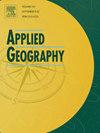Spatialities of remote work across the EU regions in the context of the Covid-19 pandemic: Regional change, factors, interlinkages
IF 4
2区 地球科学
Q1 GEOGRAPHY
引用次数: 0
Abstract
One of the most important implications of Covid-19 pertains to increasing trends of remote work, due to lockdown measures, mainly in knowledge-intensive sectors, that have changed work-life balance. These changes unfold unevenly among countries and regions, since, for instance, urban areas have a larger share of jobs that could be performed remotely. This paper studies how and why remote work unfolds unevenly across space in the context of Covid-19, thus enriching our understanding of shifting spatial organization of work after the pandemic arose. Particularly, using secondary figures from Eurostat and adopts fixed-effects and spatial error regression analysis in 217 EU NUTS2 regions with remote work rate in 2020 and the annual change between 2019 and 2020 as dependent variables. The paper then in-depth discusses and integrates the results into the regional socio-economic environment through two regions case-studies to better contextualize the findings. The results highlight the geographically uneven changes in the organization of work and the regional variation in remote working across the EU in the context of Covid-19. The regional industrial structure, policies to contain Covid-19, regional structural elements and demographics proved to be key factors of the spatialities of remote work.
2019冠状病毒病大流行背景下欧盟各区域远程工作的空间性:区域变化、因素和相互联系
Covid-19最重要的影响之一是,由于封锁措施(主要是在知识密集型部门)改变了工作与生活的平衡,远程工作的趋势日益增加。这些变化在国家和地区之间表现得不均衡,因为,例如,城市地区有更大比例的工作可以远程完成。本文研究了在2019冠状病毒病背景下,远程工作如何以及为何在不同空间中不均匀展开,从而丰富了我们对大流行爆发后工作空间组织变化的理解。特别是,利用欧盟统计局的二次数据,以2020年的远程工作率和2019 - 2020年的年度变化为因变量,对217个欧盟NUTS2地区进行固定效应和空间误差回归分析。然后,本文通过两个区域案例研究深入讨论并将结果整合到区域社会经济环境中,以更好地将研究结果置于背景中。研究结果凸显了在2019冠状病毒病背景下,欧盟各国工作组织的地域差异和远程工作的区域差异。区域产业结构、防控政策、区域结构要素和人口特征是影响远程工作空间性的关键因素。
本文章由计算机程序翻译,如有差异,请以英文原文为准。
求助全文
约1分钟内获得全文
求助全文
来源期刊

Applied Geography
GEOGRAPHY-
CiteScore
8.00
自引率
2.00%
发文量
134
期刊介绍:
Applied Geography is a journal devoted to the publication of research which utilizes geographic approaches (human, physical, nature-society and GIScience) to resolve human problems that have a spatial dimension. These problems may be related to the assessment, management and allocation of the world physical and/or human resources. The underlying rationale of the journal is that only through a clear understanding of the relevant societal, physical, and coupled natural-humans systems can we resolve such problems. Papers are invited on any theme involving the application of geographical theory and methodology in the resolution of human problems.
 求助内容:
求助内容: 应助结果提醒方式:
应助结果提醒方式:


